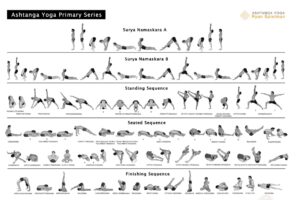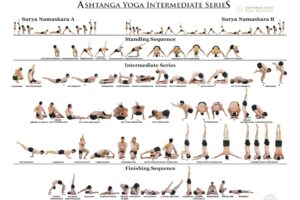Table of Contents
ToggleWhat is Ashtanga Yoga?
With the help of Krishnamacharya, Pattabhi Jois translated the Ashtanga yoga series. The Ashtanga yoga series originally consisted of six posture sequences. Pattabhi Jois’s Ashtanga yoga style is a hatha yoga that emphasizes breath control, and postures. To distinguish between Ashtanga yoga and Patanjali’s eightfold system, some people refer to this practice as Ashtanga Vinyasa yoga.
Yoga is a means of increasing awareness of the deeper, inner elements of ourselves. Ashtanga yoga ignites the soul’s fire. It awakens the untapped force of life energy that is inside each of us. The vinyasa system involves synchronizing movement with deep, rhythmic breathing.
Through the connection of the postures, a continuous flow of energy is created, increasing blood oxygenation, nourishing the internal organs, cleaning and purifying the nervous system, and causing the body to sweat out undesired pollutants. Toxins are burnt up and eliminated from the body as the temperature rises, leaving the body lighter and the mind clearer.
Key Principles of Ashtanga Yoga
Pranyama – Ujjayi Breath

The mind is erratic when the breath varies, but it is stable when the breath remains steady. The fuel that feeds, nourishes, and maintains the interior fire is breath. The breath governs prana, the essential life force. Ujjayi breathing, or “victory breath,” is a technique utilized in Ashtanga yoga to enhance prana.
A hissing sound is produced in the throat when inhaling via the nose while keeping the lips closed. The sound of breathing helps to maintain mental attention. As the breath and each position flow into the next, the mind becomes peaceful and concentrated. The connection between the mind and body is the breath.
Bandhas

Prana or vital force is drawn into and stored in the body via asana and pranayama practice, increasing energy. Three locks, or bandhas, are activated throughout an Ashtanga yoga practice to keep prana from leaving the body, guide its flow, and transform it into spiritual energy.
• Jalandhara Bandha – It helps the upper body retain prana.
• Uddiyana Bandha – Prana is forced up the Shushumana Nadi
• Mula Bandha – Apana is drawn up to join with prana and is prevented from leaving the lower body.
Mula Bandha
The power or energy produced by raising the pelvic floor and managing breathing is known as mula bandha. Everything comes alive and moves because of the root lock, which awakens the fire inside. Mula bandha promotes warmth and improves flexibility. One may direct and enhance life energy to cultivate heightened awareness and energy by clenching the perineum and bringing energy up from the base of the spine.
The flame of kundalini, or cosmic energy, the snake force, is kindled by mula bandha. Mula bandha helps avoid injury by raising awareness of the body’s core. It leads you to move from your core, bringing you into balance and enabling you to become more fluid and light in your yoga practice.
Uddiyana Bandha
The embodiment of the Divine in her feminine form is known as Shakti. By use of the flying bandha, Uddiyana Bandha, Shakti soars to new heights effortlessly, guiding prana flow even further in the direction of higher levels of consciousness.
Strong internal strengthening and toning are achieved by squeezing the lower belly and drawing it inward and upward toward the spine. By pushing up the diaphragm, this raising helps in breathing out. By aiding in breath control, the abdominal lock, or Uddiyana bandha, also relieves strain. One may increase their access to consciousness by using bandhas to increase the control over the breath.
Jalandhara Bandha
The network of subtle energy channels is bound by Jalandhar Bandha. It enhances the amount of prana in the thoracic area. Prana is trapped when the chin is pressed on the chest, keeping it from leaving the upper body. Since the neck contains many major nerve fibers, performing Jalandhara bandha presses against these nerves, limiting the flow of nerve impulses to the brain.
When the bandha is released, the impulses that have accumulated in the cervical plexus burst into the brain. These impulses have the power to stimulate the brain’s higher regions, which are responsible for intellect and creativity.
Drishti
Drishti or stare is a method of concentration. By focusing the sight at particular locations (the nose tip, between the eyebrows) the attention is fixed within. This increases the movement’s focus and consciousness. The nine types of Drishtis are:
1. Nasagrai: the area immediately behind the nose’s tip. This is the main drishti in the sitting postures and is utilized most frequently.
2. Ajna chakra: the area between the eyebrows (e.g., extreme east stretch, Purvottanasana)
3. The navel center, or Nabhi chakra (Adho Mukha Svanasana/downward dog, for example).
4. Hastagrai, or hand (such as a triangle or Trikonasana).
5. Padhayoragrai, or toes (shoulder stands, Savangasanas, etc.)
6. Parshva – far to the right (e.g., in the reclining big toe pose, Supta Padangusthasana), far left, such as in the pose of Marichyasana C or Marchi
8. Angushtha Ma Dyai Thumbs up, (start of Suryanamaskara/Sun salutation)
9. Úrdhva drishti – upwards to the sky (Virabhadrasana A /warrior A)
Purification
Nauli kriyas

The body starts to crumple and lose its form in the middle as we age. We are gravitationally drawn downward. The solar plexus, in the body, will become crushed unless we are doing some kind of opposing approach. The poisons that become trapped, impair digestion and reduce oxygen supply to the abdominal area. When used in tandem with bandhas, Nauli raises the body’s center to receive vitality once again.
As a method of internal purification, Naulis massages the internal organs and eliminates intestinal and stomach sluggishness. Early morning on an empty stomach is the ideal time to practice the Nauli kriya.
Nasal Clearing – Jala Neti

Most viruses and colds are inhaled through the nose. They then pass through our system and enter the neck, chest, and throughout the respiratory tract. Cleaning the nasal passages is one of the best methods to break that pattern. A neti pot and some water that has been mildly salted work wonders.
The whole ear, nose, and throat region’s healthy secretory drainage processes are maintained by regular Neti practice. This helps prevent tonsillitis, fever, colds, and coughs. It increases resistance against a range of throat, eye, and ear ailments. It maintains equilibrium between the left and right nostrils.
Ashtanga Sequences
Ashtanga yoga consists of six series or sequences of poses. This collaboration of breathing and moving is known as the vinyasa flow. On uses breath to transition into the next pose. Start with Sun Salutation A, followed by Sun Salutation B in each series. Think of them as a warm-up.
After the sun salutations, there is a standing sequence. Following there is a backbend sequence, inversions, and a final sequence that includes relaxation, and meditation. If you are experiencing trouble with any of the poses, adjust them to your level of comfort.
Primary Series

This is the fundamental, or first series, known as yoga Chikitsa, or yoga treatment. It intends to heal, cleanse, and reposition the body, psyche, and the spine. The Primary series’ asanas increase body strength and flexibility, releasing tense muscles, and realigning and cleansing the nervous system. Forward bends open the sequence, followed by twists and hip openers with a vinyasa in between each pose.
Intermediate Series

Nadi Shodhana, which translates to “nerve cleansing,” is the name of the Ashtanga Intermediate Series or second series. This emphasizes backbend poses and inversions. In addition to preserving the spine’s flexibility, backbends help to open the energy pathways that let the prana move freely.
Advanced Series
In the advanced series also known as Sthira Bhaga Samapta energy flow is still emphasized, but flexibility, strength, and focus are given more importance. The advanced series retains bodily stability, through arm-balancing postures. The third series of Ashtanga yoga also has difficult backbends which activate energy pathways and lengthen the spine.
Advanced Series A – The arm-balancing postures that are the main focus of Ashtanga Yoga Advance Series A demand practitioners to be aware of their core muscular strength.
Advanced Series B – Twists of the spine, shoulders, hips, knees, arms, and feet are all included along with a few backbends.
Ashtanga Series C – Along with the postures of the Primary Series, Intermediate Series, and Advance Series A, B, and C concentrate on a variety of handstand vinyasas and other inversions.
Ashtanga Series D – It starts with a standing posture sequence, two variations on the sun salutation, and ends with the same closing sequence. This extremely challenging sequence features handstands, backbends, and other inversions that call for more balance and flexibility.
- Sadhana Pada – Yoga Sutras of Patanjali Chapter 2 - April 20, 2024
- Samadhi Pada: The First Chapter Of Patanjali Yoga Sutras - April 18, 2024
- The 8 Limbs Of Yoga Explained - April 16, 2024

